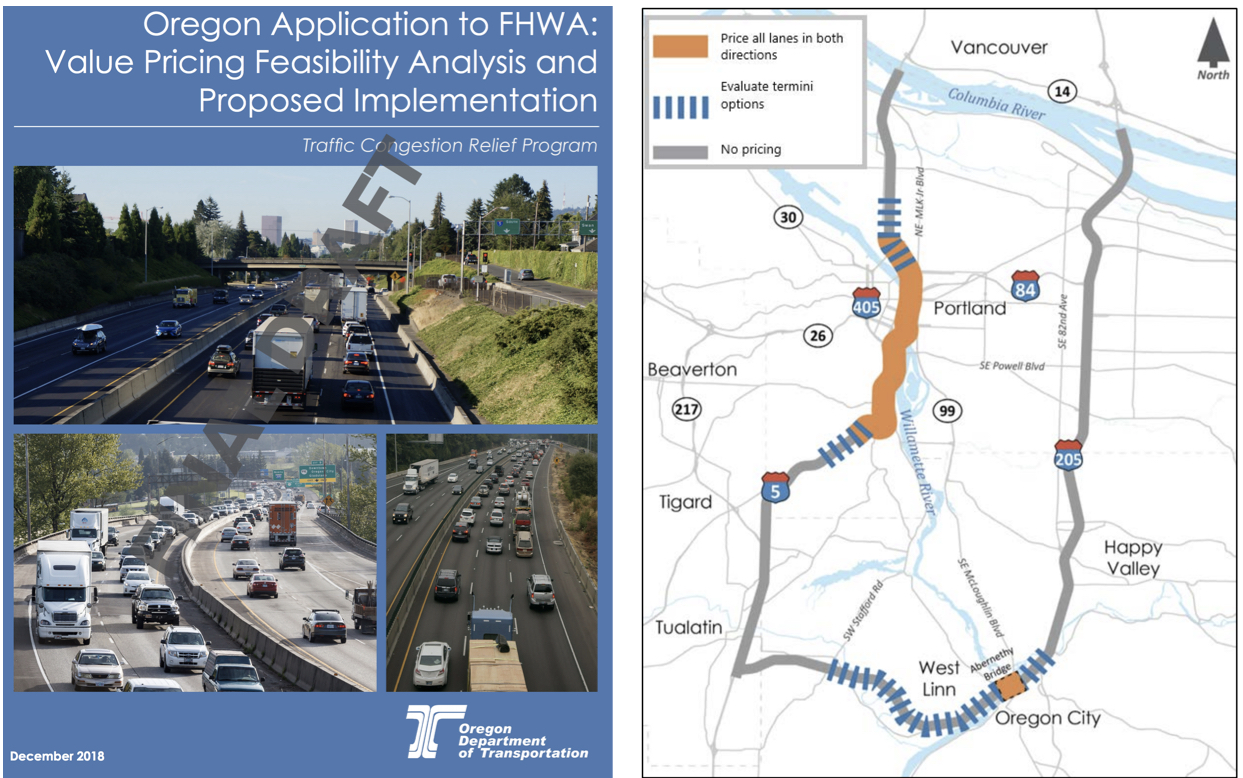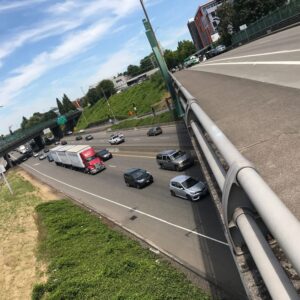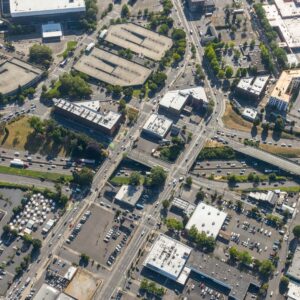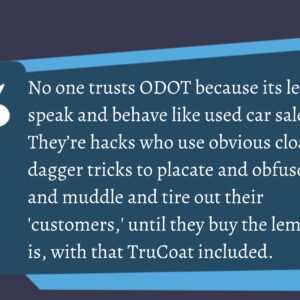
Before the Oregon Department of Transportation (ODOT) can begin any kind of congestion pricing on existing freeways, they must first submit a proposal to the Federal Highway Administration. At their monthly meeting in Salem today, ODOT’s governing body voted 5-0 in favor of that 48-page plan, marking a major step in the future of tolling in the Portland region.
In a presentation to OTC members by ODOT Region 1 Director Rian Windsheimer, the two main objectives of the plan were laid out. First, ODOT wants tolling to “create a revenue source to help fund bottleneck relief projects in the corridor.” They list two “priority projects”: widening of I-205 (Abernethy Bridge) between Highway 99 and Stafford Road; and the I-5 Rose Quarter project which will add lanes and shoulders between I-84 and I-405. The second goal is to manage traffic congestion in the I-5 and I-205 corridors.
Specifically, ODOT is asking FHWA for guidance and approval to toll I-205 “on or near the Abernethy Bridge” and I-5 “in the vicinity of N Going/ Alberta St to SW Multnomah Blvd.”
Advertisement
A policy advisory committee convened by ODOT laid out three additional priorities of the plan:
improved public transportation and other transportation options for equity and mobility; special provisions for environmental justice populations, including low income communities; and strategies to minimize and mitigate negative impacts of diversion.
ODOT needs FHWA approval in order to take the next step in analysis. ODOT says exact tolling boundaries as well as rates still need to be studied. If FHWA supports ODOT’s proposal, the agency would then take a few years to refine the projects, assess environmental impacts and determine costs associated with tolling infrastructure. “Future analysis,” ODOT said in a statement after today’s vote, “will also focus on concerns raised frequently during the feasibility analysis phase of the project, including understanding equity impacts, needed improvements to mass transit services and other travel options and minimizing diversion impacts to neighborhood streets.”
A timeline shared by ODOT today puts tolling in place by 2024 if all goes according to plan.
Among the things we’re tracking with this plan is what type of projects will be eligible for funding with tolling revenue, whether ODOT is going far enough to meet Oregon’s greenhouse gas emission targets, and how tolling might impact neighborhood streets.
Learn more about ODOT’s work on congestion pricing here and read download a PDF of their application to the FHWA here. (The “Reason Statement” begins on page 19).
— Jonathan Maus: (503) 706-8804, @jonathan_maus on Twitter and jonathan@bikeportland.org
Never miss a story. Sign-up for the daily BP Headlines email.
BikePortland needs your support.







Thanks for reading.
BikePortland has served this community with independent community journalism since 2005. We rely on subscriptions from readers like you to survive. Your financial support is vital in keeping this valuable resource alive and well.
Please subscribe today to strengthen and expand our work.
I love hearing the “I paid my fair share” statements from drivers who cannot comprehend that only about 40% of ODOT budget is from gas tax and registrations.
The motorist community will be up in arms against this.
Yes, there is already a ballot measure moving its way forward towards the 2020 election that would require voter approval to toll existing roads. It sounds like no voter approval would be needed if new lanes/capacity are added.
I am for tolling, but I’m also worried Barbur will just become I-5-lite. London does de-congestion pricing as an entire toll zone, not only on their equivalent of the interstate. If we do tolling, I think it should be an entire ring into core Portland.
Given that we generally accept drivers believe “war on motorists,” and that they don’t understand how roads are not properly funded from the gas tax, it seems silly to think they would accept the toll at face value and not try to avoid it.
Better speed up the SW corridor project and put Barbur on a road diet before this starts, then.
Here’s a crazy thought: let’s use congestion tolling to fund mass transit and road safety projects.
Me too. I bike Barbur every day, and the Bridges section is already terrifying enough. I sent an email to Metro and PBOT when the SW Corridor plan was published (or at least that last big release of planning), suggesting that rebuilding the Vermont/Newbury bridges be fast-tracked for the next 5 years. If traffic is going to double/triple on that part of Barbur, separated bike/walk infrastructure (real separation, not the 2 foot wide sidewalk that’s there now) needs to be there BEFORE tolling goes into place.
Looks like they pulled the north (and east) end back so as to not have to deal with SW Washington’s wrath. (Remember: Portland employers…you do not have to hire folks north of the Columbia River or if hired, work to get them to move to Oregon!)
[There are so many Oregon plated cars “resting” in my downtown Vancouver neighborhood, I have lost count.]
There is also the retail aspect that tolling could dampen.
I don’t understand why it would take up until 2024 to put tolls in place. Assuming the FHWA supports the proposal, put it in place ASAP and see if the other big ticket projects, like the Rose Quarter widening, are even needed after tolling has a chance to change traffic patterns. I may be mistaken, but doesn’t this just involve granting a concession to a private company who installs the cameras and manages the billing? Sure, it will take some time, but five years seems slow for a such a modest plan.
The technical aspects of tolling are simple. It’s the politics of it that are the reason for the cautious timeline.
Simple?
Tolling is done electronically these days. Little RFID tags on the vehicle, with overhead gantries over the lanes. So, there is the design work, the construction, the mailing out and management of tags, the pre-toll locations for non-registered drivers to pull out and purchase a tag – one for each direction approaching the toll zone with on and off ramps; and before the actual implementation the political process to determine what to charge and who to charge.
The east coast has interchangeable systems, where one id tag works on different state systems, so that possibility of integration to a common platform is another wrinkle. BC has a system in place, so would I need another tag for the OR system, or would my current tag work?
Tolling is also done optically and billed through the mail for unenrolled vehicles. Typically, optical reads are billed at a higher rate to encourage enrollment. Regardless, tolling can be designed as opt in and doesn’t require pullout locations for unenrolled vehicles or collection booths.
I don’t mean to underestimate the time it takes the political process to play out, but political opposition will use false claims around needed infrastructure and supporting systems, which again, are minimal and can likely be outsourced to reduce risks/costs and speed implementation.
Then there is the right to privacy argument used to attack anything that hints at ‘big brother’.
Do any of the plans have High Occupancy Vehicle HOV/toll lane combos as an option? Making it faster for buses to travel and people willing to carpool is such a noibrainer that most cities combine with their tolling strategies. Is that on the table for any of these plans? Portland is very unique in the country for having almost no HOV lanes. Can one lane of each bridge into downtown also become and HOV lane. People might actually take the bus. I think the Central City In Motion Plans have spoken to these possibilities. How is HOV not even in Portlanders’ lexicon?
During the online open house hosted by ODOT earlier this year, this was the message I kept repeating “only add BUS ONLY lanes to the Abernathy Bridge, the I-205 interchange with I-84, and the Rose Quarter” otherwise don’t add them.
Congestion pricing so they can build more freeway that will result in more congestion. Maybe it’s best to let the whole system be. Let it collapse, then see what rises out of the ashes. Hopefully, the Big One will do away with the whole congestion problem for a long, long time?
Congestion won’t be an issue when the big one hits Portland because it’s going to be survival mode time. I’d recommend stocking up on supplies and ammo.
Agreed. We should just abandon the city now, to be safe.
Around the time that the Seattle metro area decided to go big on HOV lanes (after repeated rail ballot issues failed), the Portland area decided the opposite. (late 70’s/early 80’s) They would forego HOV lanes in favor of the MAX system. The only on-freeway HOV lane is the useless stretch in north Portland that is leftover from the 1997 Trunnion project mitigation.
With Lynn Peterson leading Metro,and her experience at WSDOT and HOV/HOT lanes, maybe the philosophy will change.
Adding HOV lanes doesn’t get people to stop driving so much. BTW, the reason they added lanes, with the associated cost ($$$$), is because general purpose lanes weren’t allowed to be tolled, and such policies are changing.
Apart from the fact that the Seattle region still has traffic jams with, and in, those HOV lanes.
Main objectives: (1) Add more lanes for traffic. (2) Try to figure out how to control all the traffic congestion we’ve just created.
Great job there ODOT.
Typical politics. Present something people want (control of traffic congestion) and add a rider on there that nobody wants (more lanes of congested traffic on the freeway).
Of course the highway department will approve this; it adds more traffic and continues the dominance of car culture. It’s all they know how to do.
With the amount of money they spend putting more cars idling on the freeway they could build MAX to every metro city and run the entire system fare-free.
In addition they need to add safe, high quality separated bikeways to all major roads, and create Dutch-style protected intersections along the route. Most people are already willing to ride on the minor suburban streets, but are rightfully afraid of the major roads. If we can make all the main roads safe and attractive for biking the numbers will skyrocket.
Exactly.
If they’re going to add car lanes, they could add a MUP for what would be a rounding error of the total project cost.
The I205 stafford 99E connection is an ideal route for an MUP. It’s already wide, it’s flat, direct, and there are no other reasonable routes a person can ride a bike to connect those two points.
Run the path all the way to Wilsonville/Tualatin and you’d have a national leader in bike access.
2024? Assuming this gets done on time, that means I only need to deal with for 4 years before I can retire and get the heck out of Portland. Not bad.
“First, ODOT wants tolling to “create a revenue source to help fund bottleneck relief projects in the corridor.”
So this is proposal is focused on funding highway expansion and making it easier to drive, not supporting alternatives. If so, this proposal is a huge step in the wrong direction.
Hands are tied on this one. The state constitution explicitly requires revenue from rolling be used on road projects. This is what happens when taxes and fees are written into the constitution.
Um, protected bike lanes, dedicated bus lanes, and true safety projects are all road projects too. This is a political decision (out of the belief that the people who’ll have to pay the toll will be less annoyed if the money is used to expand the freeways), not a legal one, even though there are some legal constraints.
If revenues are going to ODOT, those funds would be used on ODOT maintained rights of way, no? AFAIK most streets in the city are PBOT. Correct me if I’m wrong, thinking out loud here.
ODOT does (and will) fund projects on PBOT streets, as long as they are higher level safety priorities. This is one of the mechanisms: https://www.oregon.gov/ODOT/Engineering/Pages/ARTS.aspx
There might be others too but it’s the first one that comes to mind.
Nope.
One of many examples:
https://www.portlandoregon.gov/transportation/article/441015
Plus, ODOT ROWs can use TONS of things that aren’t freeway expansion. Many of the major roads in the metro area are ODOT roads, and could use dedicated bus lanes and protected bus lanes. I’m not absolutely certain that sidewalks are fundable with road money, but I bet they are, and there are huge swathes of ODOT highways that don’t have sidewalks.
And, we have a maintenance deficit that ODOT loves to swing around when it wants more money. Well, here’s a pile of new money from tolling. If nothing else truly progressive, can’t we at least just plug our maintenance deficit with it rather than expand freeways?
Sigh, this plan is just going to shunt more traffic into the neighborhoods. If ODOT wants to reduce congestion, it should toll I-5 and I-205 all the way from Columbia crossings down to Wilsonville.
I think the politics will ultimate dictate tolling at the stateline, or don’t toll at all. The cut-through traffic means PBOT will never stand for ODOT shunting all of that traffic onto local streets. But if the I-5 toll is at the Interstate Bridge, you also have to toll the Glenn Jackson Bridge on I-205 to prevent diversion. (This was a major finding in the modeling done for the CRC and one more reason for everyone to hate that project.)
It’ll be fun to watch ODOT try to weasel their way through the upcoming political s**tshow. Because there’s no easy or apparent solution to implementing tolling. It’s been discussed and studied for years and never attempted because of all of the logistical and political hurdles. Pass the popcorn, please…
“The cut-through traffic ”
Just like induced demand is a thing, so is reduced demand (disappearing traffic, traffic evaporation).
Exactly. Of all the initial proposals tolling the whole thing is the only one that makes sense. They went with the minimal amount of tolling option it seems.
New slogan:
“ODOT: Do the bare minimum!”
Let’s not forget why car culture and auto dominance is even a thing: poor urban planning generations ago that sought to separate land uses via zoning. This is still a thing and landowners will not take kindly to changing it. Allowing for greater density in existing single family areas will not only help reduce auto dependence, but it will also help with housing costs. Cars suck, but let’s not kid ourselves, those that have been priced out of inner neighborhoods now live in car reliant areas that are difficult and/or expensive to effectively serve with transit and cycling infrastructure. They’re going to be the ones hardest hit by tolls.
Adding to that – we’re at a point where no one alive remembers a time before cars and single-use zoning weren’t ubiquitous.
Everyone grew up using cars to get everywhere and can’t fathom an alternative that doesn’t involve cars.
I’m one of those who have been priced out of inner city neighborhoods. I would love to have bought a house in Johns Landing and stayed in a livable, walkable neighborhood! The housing stock there is simply too expensive, and rent just kept going up, so now I have a house in Oaks Lodge and I have to drive everywhere.
I commute every day on the I205 stretch in the article and I guarantee you that the traffic will only get worse when the extra lanes go in. There’s not even all that much traffic, but people are so bad at maintaining a speed, that it’s constantly stop and go congestion.
Maybe, instead of more lanes or congestion charging, we could do peak-time lowered speed limits with photo ticketing.
Yeah, 40mph is slower than 70mph, but a constant 40mph is worlds more pleasant than averaging 40mph because thousands of people are trying to drive as fast as possible, all the time, slamming on their brakes from 70mph to 0.
The worst part is being complicit in the traffic, sitting alone in a car, when I know the joy of biking to work 5 days a week.
Compared to the political aspects of tolling, the technology is relatively simple. Yes, it’s complex, but not as complex as the politics.
I wish we could toll exits into downtown, rather than the entire freeway. Those traveling from Vancouver to Salem, IMO, are using the freeway for it’s intended purpose to pass through the city without clogging the grid, and that use should not be tolled. Those using the freeway to travel short distances into town—especially if there is a transit alternative—are the ones who need to think twice about whether there is another option besides driving. As was mentioned in another comment, Portland should consider London’s example of a congestion zone all around the city core. Exits from 405 and 26 onto downtown surface streets should also be tolled. I don’t know how London does it unless they use GPS on vehicles, but starting with freeway exits would at least be a step in the right direction.
The toll is charged based on where the vehicle enters and exits the tolling zone and prices are variable. Nothing in the proposed design precludes your wish as far as I can tell. The rate for entering one end and exiting another could be set to zero.
That would be great. The way it always reads to me is that one would pay to traverse the tolled sections no matter where or whether one exited. Where is the actual toll structure explained?
That’s a really good idea.
It’s similar to bus lines where you pay when you exit the bus instead of when you get on.
On one hand, ODOT is working overtime to inflict the largest freeway expansion in recent history…but on the other hand, they want to tax traffic around the same around.
So, are those carpool lanes in yet on all freeways in an out of Portland?
The debate is starting on a “congestion pricing “ (read: tollway) proposal in Los Angeles on several of their main freeways, including I-5, I-10, and CA-60, and possibly others as well. Keep an eye on that one, as some of the issues being raised here are going to be mentioned down there. They’ve had toll lanes on CA-91 and several tollways built in Orange County in recent years. All of those projects use EZ Pass tag systems like the ones widely used back East. (Those who don’t have EZ Pass are routed off the main line to pay cash at tollbooths; this system is used on the NJ and Garden State Parkways, for example.)
The kid in me likes the toll, the adult in me thinks this will encourage more cars to use surface roads.
where are we in the tolling process?
NEPA ?
Has ODOT returned/reported to the Joint Committee on Transportation ?
Yes we are overdue for an update on this. Will try to make it happen asap.
I did see this BikePortland article from January 2021…
https://bikeportland.org/2021/01/11/oregon-house-bill-would-prohibit-tolling-on-i-205-324670